Purchasing a home is one of the most significant investments most people will make in their lifetime. Securing a low-interest home loan can make this investment much more manageable and affordable. With the right strategies, you can position yourself to obtain a home loan with favorable terms, saving you thousands of dollars over the life of the lån. Here are some essential tips to help you secure a low-interest home loan.
1. Understand Your Credit Score
Your credit score is a crucial factor that lenders use to determine your eligibility for a home loan and the interest rate you will be offered. Generally, the higher your credit score, the lower the interest rate. Most lenders consider a score of 740 or higher as excellent. Here are steps to improve your credit score before applying for a mortgage:
- Check Your Credit Report: Obtain a free copy of your credit report from the major credit bureaus (Equifax, Experian, and TransUnion) to check for errors.
- Pay Off Debts: Reduce your credit card balances and pay off any outstanding debts. A lower credit utilization ratio can improve your score.
- Make Payments on Time: Ensure all your bills are paid on time. Late payments can significantly impact your credit score.
2. Save for a Larger Down Payment
A larger down payment can not only reduce the amount you need to borrow but also help you secure a lower interest rate. Many lenders offer better rates for borrowers who can put down at least 20% of the home’s purchase price. If saving for a 20% down payment seems daunting, consider these tips:
- Create a Savings Plan: Set a monthly savings goal to reach your down payment target within a specific timeframe.
- Cut Unnecessary Expenses: Review your monthly expenses and find areas where you can cut back to increase your savings.
3. Research Loan Options
Understanding the different types of home loans available can help you choose the right one for your financial situation. Some common loan types include:
- Fixed-Rate Mortgages: These loans have a constant interest rate and monthly payments that never change. They are ideal for those who plan to stay in their home long-term.
- Adjustable-Rate Mortgages (ARMs): These loans typically offer lower initial rates that adjust after a specified period. They can be a good option if you plan to sell or refinance before the adjustment period begins.
- FHA and VA Loans: If you qualify, these government-backed loans can offer lower interest rates and down payment requirements.
4. Shop Around for Lenders
Not all lenders offer the same rates and terms. It’s essential to shop around and compare offers from multiple lenders. Here are some strategies to help you find the best deal:
- Get Pre-Approved: Obtain pre-approval from several lenders. This process will give you a better idea of what you can afford and allow you to compare interest rates and fees.
- Negotiate Terms: Don’t hesitate to negotiate terms with lenders. If you have received a better offer from another lender, use it as leverage to negotiate a lower rate.
5. Consider the Loan Term
The length of your loan can significantly affect your interest rate. While a 30-year mortgage is standard, you might consider shorter-term loans with the support of lånno.no, such as 15 or 20 years. These loans often come with lower interest rates, though your monthly payments will be higher. Weigh the pros and cons of each option based on your financial situation and long-term goals.
6. Improve Your Debt-to-Income Ratio
Your debt-to-income (DTI) ratio is another critical factor lenders consider when determining your eligibility for a loan. This ratio compares your monthly debt payments to your gross monthly income. A lower DTI indicates that you have a good balance between debt and income, making you a less risky borrower. To improve your DTI:
- Pay Down Existing Debt: Focus on paying off high-interest debt, such as credit cards, to lower your DTI.
- Increase Your Income: Consider ways to boost your income, such as taking on a part-time job or freelance work.
7. Lock in Your Rate
Once you find a favorable interest rate, consider locking it in. A rate lock guarantees that your interest rate will not increase before you close on your mortgage. Rate locks typically last for 30 to 60 days, giving you time to finalize your loan. Check with your lender about their rate lock policies.
8. Consider Points
Mortgage points are fees you can pay upfront to lower your interest rate. One point equals 1% of the loan amount. Buying points can be a smart financial move if you plan to stay in your home long enough to recoup the costs through lower monthly payments. Before deciding to buy points, calculate the break-even point to see if it’s worth the investment.
9. Be Cautious with Your Financial Moves
Avoid making significant financial changes before closing on your home loan. This includes:
- Changing Jobs: Lenders prefer stable employment. A job change, especially to a lower-paying job, can raise red flags.
- Taking Out New Loans: Avoid applying for new credit or loans, as this can affect your credit score and increase your DTI.
10. Seek Professional Advice
Consider consulting with a financial advisor or mortgage broker. These professionals can provide personalized advice based on your financial situation and help you navigate the loan process to find the best rates and terms.
Conclusion
Securing a low-interest home loan requires careful planning and proactive measures. By understanding your credit score, saving for a larger down payment, shopping around for lenders, and being mindful of your financial situation, you can significantly improve your chances of obtaining favorable loan terms. With the right approach, you’ll be well on your way to making your dream of homeownership a reality while keeping your mortgage costs manageable






